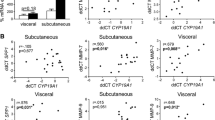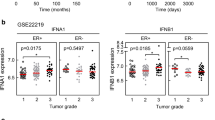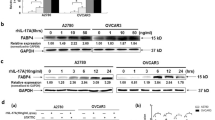Abstract
Obesity is associated with a worse breast cancer prognosis, particularly in estrogen receptor alpha (ERα) positive, postmenopausal patients. We hypothesized that this is mediated in part by an elevation in breast cancer cell cyclooxygenase-2 (COX-2) expression and prostaglandin E2 (PGE2) production that results in greater local pre-adipocyte aromatase expression. We utilized an in vitro model of the obese patient’s tumor microenvironment in which cultured MCF-7 breast cancer cells and pre-adipocytes were exposed to pooled serum from obese (OB; BMI ≥ 30.0 kg/m2) or normal weight (N; BMI 18.5–24.9 kg/m2) postmenopausal women. Exposure to OB versus N sera significantly increased MCF-7 cell COX-2 expression and PGE2 production. Pre-adipocyte aromatase expression was 89 % greater following culture in conditioned media (CM) from MCF-7 cells exposed to OB versus N sera (OB-CM and N-CM, respectively), a difference nullified by MCF-7 cell treatment with the COX-2 inhibitor celecoxib. Previous analysis of the sera revealed significantly higher interleukin-6 (IL-6) concentrations in the OB versus N samples. Depletion of IL-6 from the sera neutralized the difference in pre-adipocyte aromatase expression stimulated by OB-CM versus N-CM. Finally, CM from pre-adipocyte/MCF-7 cell co-cultures exposed to OB sera stimulated greater MCF-7 and T47D breast cancer cell ERα activity and proliferation in comparison to N sera. This study indicates that obesity-associated systemic IL-6 indirectly enhances pre-adipocyte aromatase expression via increased breast cancer cell PGE2 production. Investigation regarding the efficacy of a COX-2 inhibitor/aromatase inhibitor combination therapy in the obese postmenopausal patient population is warranted.




Similar content being viewed by others
References
Howlader N, Noone AM, Krapcho M, Garshell J, Neyman N, Altekruse SF, Kosary CL, Yu M, Ruhl J, Tatalovich Z, Cho H, Mariotto A, Lewis DR, Chen HS, Feuer EJ, Cronin KA (2013) SEER cancer statistics review, 1975–2010, National Cancer Institute. http://seer.cancer.gov/csr/1975_2010/. Accessed 2 Sept 2014
Anders CK, Hsu DS, Broadwater G, Acharya CR, Foekens JA, Zhang Y, Wang Y, Marcom PK, Marks JR, Febbo PG, Nevins JR, Potti A, Blackwell KL (2008) Young age at diagnosis correlates with worse prognosis and defines a subset of breast cancers with shared patterns of gene expression. J Clin Oncol 26:3324–3330
Flegal KM, Carroll MD, Kit BK, Ogden CL (2012) Prevalence of obesity and trends in the distribution of body mass index among US adults, 1999–2010. JAMA 307:491–497
Protani M, Coory M, Martin JH (2010) Effect of obesity on survival of women with breast cancer: systematic review and meta-analysis. Breast Cancer Res Treat 123:627–635
Calle EE, Rodriguez C, Walker-Thurmond K, Thun MJ (2003) Overweight, obesity and mortality from cancer in a prospectively studied cohort of U.S. adults. N Engl J Med 348:1625–1638
Chlebowski RT, Aiello E, McTiernan A (2002) Weight loss in breast cancer patient management. J Clin Oncol 20:1128–1143
Senie RT, Rosen PP, Rhodes P, Lesser ML, Kinne DW (1992) Obesity at diagnosis of breast carcinoma influences duration of disease-free survival. Ann Intern Med 116:26–32
Majed B, Moreau T, Senouci K, Salmon RJ, Fourquet A, Asselain B (2008) Is obesity an independent prognosis factor in woman breast cancer? Breast Cancer Res Treat 111:329–342
McTiernan A, Wu L, Chen C, Chlebowski R, Mossavar-Rahmani Y, Modugno F, Perri MG, Stanczyk FZ, Van Horn L, Wang CY (2006) Relation of BMI and physical activity to sex hormones in postmenopausal women. Obesity 14:1662–1677
Hankinson SE, Willett WC, Manson JE, Hunter DJ, Colditz GA, Stampfer MJ, Longcope C, Speizer FE (1995) Alcohol, height, and adiposity in relation to estrogen and prolactin levels in postmenopausal women. J Natl Cancer Inst 87:1297–1302
Cauley JA, Gutai JP, Kuller LH, LeDonne D, Powell JG (1989) The epidemiology of serum sex hormones in postmenopausal women. Am J Epidemiol 129:1120–1131
Sestak I, Distler W, Forbes JF, Dowsett M, Howell A, Cuzick J (2010) Effect of body mass index on recurrences in tamoxifen and anastrozole treated women: an exploratory analysis from the ATAC trial. J Clin Oncol 28:3411–3415
Schmid P, Possinger K, Bohm R, Chaudri H, Verbeek A, Grosse Y, Luftner D, Petrides P, Sezer O, Wischnewsky M (2000) Body mass as predictive parameter for response and time to progression (TTP) in advanced breast cancer patients treated with letrozole or megestrol acetate. Proc Annu Meet Am Soc Clin Oncol 2000:19
Folkerd EJ, Dixon JM, Renshaw L, A’Hern RP, Dowsett M (2012) Suppression of plasma estrogen levels by letrozole and anastrozole is related to body mass index in patients with breast cancer. J Clin Oncol 30:2977–2980
Suzuki T, Miki Y, Ohuchi N, Sasano H (2008) Intratumoral estrogen production in breast carcinoma: significance of aromatase. Breast Cancer 15:270–277
O’Neill JS, Elton RA, Miller WR (1988) Aromatase activity in adipose tissue from breast quadrants: a link with tumour site. Br Med J 296:741–743
Zhou J, Gurates B, Yang S, Sebastian S, Bulun SE (2001) Malignant breast epithelial cells stimulate aromatase expression via promoter II in human adipose fibroblasts: an epithelial-stromal interaction in breast tumors mediated by C/EBPbeta. Cancer Res 61:2328–2334
Fain JN (2006) Release of interleukins and other inflammatory cytokines by human adipose tissue is enhanced in obesity and primarily due to the nonfat cells. Vitam Horm 74:443–477
Maihofner C, Charalambous MP, Bhambra U, Lightfoot T, Geisslinger G, Gooderham NJ (2003) Expression of cyclooxygenase-2 parallels expression of interleukin-1beta interleukin-6, and NK-kappaB in human colorectal cancer. Carcinogenesis 24:665–671
Falcone DJ, Sakamoto J, Steenport ML, Khan KM, Du B, Dannenberg AJ (2007) Interleukin 6 stimulates macrophage MMP-9 expression via COX-2 dependent induction of PGE2 synthesis and engagement of the EP4 receptor. FASEB J 21(383):3
Geng Y, Blanco FJ, Cornelisson M, Lotz M (1995) Regulation of cyclooxygenase-2 expression in normal human articular chondrocytes. J Immunol 155:796–801
Bowers LW, Cavazos DA, Brenner AJ, Hursting SD, Maximo IX, Degraffenried LA (2013) Obesity enhances nongenomic estrogen receptor crosstalk with the PI3K/Akt and MAPK pathways to promote in vitro measures of breast cancer progression. Breast Cancer Res 15:R59
Ghosh S, Choudary A, Ghosh S, Musi N, Hu Y, Li R (2009) IKKbeta mediates cell shape-induced aromatase expression and estrogen biosynthesis in adipose stromal cells. Mol Endocrinol 23:662–670
Bowers LW, Maximo IX, Brenner AJ, Beeram M, Hursting SD, Price RS, Tekmal RR, deGraffenried LA (2014) NSAID use reduces breast cancer recurrence in overweight and obese women: role of prostaglandin-aromatase interactions. Cancer Res 74:4446–4457
Nam SY, Lee EJ, Kim KR, Cha BS, Song YD, Lim SK, Lee HC, Huh KB (1997) Effect of obesity on total and free insulin-like growth factor (IGF)-1, and their relationship to IGF-binding protein (BP)-1, IGFBP-2, IGFBP-3, insulin, and growth hormone. Int J Obes Relat Metab Disord 21:355–359
Frystyk J, Vestbo E, Skjaerbaek C, Mogensen CE, Orskov H (1995) Free insulin-like growth factor in human obesity. Metabolism 44:37–44
Wolters R, Schwentner L, Regierer A, Wischnewsky M, Kreienberg R, Wöckel A (2011) Endocrine therapy in obese patients with primary breast cancer: another piece of evidence in an unfinished puzzle. Breast Cancer Res Treat 131:925–931
Meng L, Zhou J, Sasano H, Suzuki T, Zeitoun KM, Bulun SE (2001) Tumor necrosis factor alpha and interleukin 11 secreted by malignant breast epithelial cells inhibit adipocyte differentiation by selectively down-regulating CCAAT/enhancer binding protein alpha and peroxisome proliferator-activated receptor gamma: mechanism of desmoplastic reaction. Cancer Res 61:2250–2255
Ackerman GE, Smith ME, Mendelson CR, MacDonald PC, Simpson ER (1981) Aromatization of androstenedione by human adipose tissue stromal cells in monolayer culture. J Clin Endocrinol Metab 53:412–417
Price T, Aitken J, Head J, Mahendroo M, Means G, Simpson E (1992) Determination of aromatase cytochrome P450 messenger ribonucleic acid in human breast tissue by competitive polymerase chain reaction amplification. J Clin Endocrinol Metab 74:1247–1252
Deb S, Zhou J, Amin SA, Imir AG, Yilmaz MB, Lin Z, Bulun SE (2006) A novel role of sodium butyrate in the regulation of cancer-associated aromatase promoters I. 3 and II by disrupting a transcriptional complex in breast adipose fibroblasts. J Biol Chem 281:2585–2597
Chen D, Reierstad S, Lin Z, Lu M, Brooks C, Li N, Innes J, Bulun SE (2007) Prostaglandin E(2) induces breast cancer related aromatase promoters via activation of p38 and c-Jun NH(2)-terminal kinase in adipose fibroblasts. Cancer Res 67:8914–8922
Chen D, Reierstad S, Fang F, Bulun SE (2011) JunD and JunB integrate prostaglandin E2 activation of breast cancer-associated proximal aromatase promoters. Mol Endocrinol 25:767–775
Morris PG, Hudis CA, Giri D, Morrow M, Falcone DJ, Zhou XK, Du B, Brogi E, Crawford CB, Kopelovich L, Subbaramaiah K, Dannenberg AJ (2011) Inflammation and increased aromatase expression occur in the breast tissue of obese women with breast cancer. Cancer Prev Res 4:1021–1029
Subbaramaiah K, Morris PG, Zhou XK, Morrow M, Du B, Giri D, Kopelovich L, Hudis CA, Dannenberg AJ (2012) Increased levels of COX-2 and prostaglandin E2 contribute to elevated aromatase expression in inflamed breast tissue of obese women. Cancer Discov 2:356–365
Subbaramaiah K, Howe LR, Bhardwaj P, Du B, Gravaghi C, Yantiss RK, Zhou XK, Blaho VA, Hla T, Yang P, Kopelovich L, Hudis CA, Dannenberg AJ (2011) Obesity is associated with inflammation and elevated aromatase expression in the mouse mammary gland. Cancer Prev Res 4:329–346
Acknowledgments
LB was supported by a Predoctoral Traineeship Award from the United States Department of Defense, Breast Cancer Research Program (BCRP) of the Congressionally Directed Medical Research Programs (CDMRP) (Award Number W81XWH-11-1-0132).
Conflict of interest
The authors declare that they have no conflict of interest.
Ethical Standards
The experiments described here comply with the current laws of the country in which they were performed.
Author information
Authors and Affiliations
Corresponding author
Rights and permissions
About this article
Cite this article
Bowers, L.W., Brenner, A.J., Hursting, S.D. et al. Obesity-associated systemic interleukin-6 promotes pre-adipocyte aromatase expression via increased breast cancer cell prostaglandin E2 production. Breast Cancer Res Treat 149, 49–57 (2015). https://doi.org/10.1007/s10549-014-3223-0
Received:
Accepted:
Published:
Issue Date:
DOI: https://doi.org/10.1007/s10549-014-3223-0




